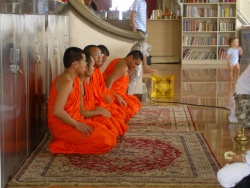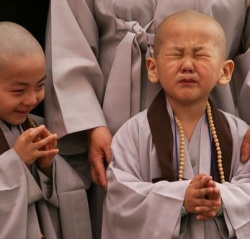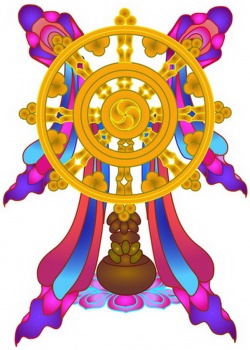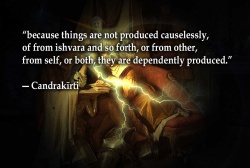Mahagovinda Sutta
- In this sutta, the Buddha is staying at Vulture’s Peak (Griddhraj Parvat) in Rajagaha, the same place as at the opening of the Mahaparinibbana Sutta. Located near the village of Devrajnagar, it consists of four caves and is unique in the world for the large number of vultures that congregate there.
Shortly before sunrise, Pancasikha appears as a “splendid radiance.”This is the same Pancasikha as the previous sutta, described as a young boy, beloved by the devas. Here we learn that he is a gandhabba, an attendant of Dhrtarastra, the guardian of the east and god of music, harmony, and compassion, in the realm of the Four Great Kings. Sanat Kumara chooses to appear to the devas of the realm of the 33 Gods as the lowest rank of deva.
Pancasikha is also a messenger between the realm of the 33 Gods and the Four Great Kings, who together monitor human progress, and probably a musician too. Gandhabbas are aerial, associated with flowers and trees, and dwell in the scents of bark, sap, and blossom, rather like fairies. His name means “five top-knots,” alluding to the style of his hair which he wore in the same style as when he died as a young boy. Pancasikha has some of the characteristics of Mercury in the Greek pantheon.
Pancasikha comes to the Buddha in his capacity as messenger, conveying to him the same story that we heard in the previous sutta in which Sakka, the chief of the realm of the 33 Gods, praises the Buddha in eight statements in which he declares that the Buddha is:
Supreme among teachers in compassion for the world.
Supreme amongst teachers for the quality of his dharma, described as “here and now, timeless, inviting inspection, leading onward, to be realized by the wise each one for himself” – a description which we have already encountered in sutta 18 and will not go into again here.
Supreme amongst teachers for the quality of his moral and ethical teachings.
Supreme amongst teachers for his explanation of Buddhist practice.
Supreme among teachers for the quality of his sangha.
Supreme amongst teachers for good reputation without conceit on his part.
Supreme amongst teachers for the mutual coherence of his speech and his actions, a quality that we observed in sutta 16, where king Ajatasattu attempts to use the Buddha as an oracle to divine the outcome of his war with the Vajjians.
Supreme amongst teachers for certainty of mind.
In response to such praise, some of the gods exclaim, “Oh, if only four fully enlightened Buddhas were to arise in the world, and teach Dhamma just like the Blessed Lord!” In the last talk, I suggested that this sutta in which this assembly is documented describes a previous kalpa. However, this passage suggests that the Buddha of that time was in fact Kakusandha, who was succeeded by three Buddhas, Konagamma, Kassapa, and Gotama, and who is to be followed by Maitreya, five Buddhas in all (Kakusandha plus four more). Such an age is both rare and fortunate.
Sakka sets forth an important principle of Buddhist cosmology: that only one Buddha can exist in a single “world-system” at any given time. What this means in the context of modern cosmology is somewhat obscure. Is a “world-system” a dharma age, a planet, a solar system, a galaxy, or universe? All of these are world-systems, or kappas.
The appearance of Sanatkumara is similar to the previous sutta, and I will not repeat myself here. Instead, Sanatkumara asks the 33 gods, “For how long has the Blessed Lord been one of mighty wisdom,” and proceeds to tell a tale based on that theme. KrishnaGovinda Krishna
The story is that of King Disampati, whose religious adviser (purohita) was called the Steward (Govinda, lit. “cowherd,” an epithet of Krishna). Although this was a Brahmanic religious office, the Steward was also an expert in business and managed all of the king’s worldly affairs too. The king’s son’s name was Renu, and the Steward’s son was called Jotipala. Together with six other ksatriyas, they formed a group of eight friends. The king was becoming something of a dissolute, and just when he was beginning to abandon himself to the pleasures of the five senses the Steward died, to the king’s regret.
Renu recommends to Disampati that he allow Jotipala to manage his affairs, to which the king agrees. Jotipala fulfilled this royal function well, and became known as the Great Steward. As Disampati became decrepit with age and entered into his dotage, Jotipala went to the six friends and encouraged them to approach Renu and suggest that he share the kingship with them after his father’s death. After Disampati died, the Kshatriya assembly (another sign of nascent democracy) appointed Renu as a constitutional monarch, after which, like his father, he abandoned himself to the pleasures of the six senses. Jahampati sent the six nobles to remind King Renu of his duty. Therefore, King Renu had Jahampati divide his kingdom – which appears to have been identical with the Indian subcontinent – into seven parts, the central part for himself, and the remaining six parts for the six nobles.
These became known as the seven Bharat kings, Bharata being the original term for India, after Bharata, the mythological emperor and founder of the Bharata dynasty. Thus, Jotipala became the Great Steward of the seven kings. He also taught the mantras to seven notable Brahmans and 700 advanced students.
Jotipala himself became so notable that he acquired the reputation of conversing with God (Brahma). Although this was not in fact true, Jotipala decided to undertake the metta meditation during the rainy season (July to October) to try to be worthy of his own reputation. The metta meditation is of course the meditation on loving kindness, which the Buddha introduced in sutta 13 as the way to achieve Union with God, the goal of Brahmanism. We encountered the famous metta meditation in sutta 13, so I don’t think we need to go into it further here. Therefore, Jotipala took leave of his 40 wives and withdrew to a building that he had built east of the city to withdraw into meditation and no one came near him except to bring him food. However, at the end of this time, the Great Steward had not experienced any success and was dissatisfied, whereupon Sanatkumara appeared before him in a splendid, glorious, and divine vision. Jotipala offers a seat, water for the feet, and cakes to Sanatkumara, who in return offers Jotipala a boon – an archetypal mytholological theme that we find repeated worldwide, and which underlies the ngondro practice of mandala offering in Tibetan Buddhism.
Jotipala asks Sanatkumara how mortals can achieve the deathless Brahma world, noting that he asks both for himself and for others. This is of course the Brahman view of the Brahma world, not the Buddhist view, which holds all worlds and their inhabitants to be subject to mortality. Sanatkumara replies that to reach the deathless Brahma world he must abandon the householder life and enter into homelessness, abandoning his possessions and family; live alone in the forest, at the foot of a tree, in a mountain glen, in a rocky cave, in a charnel ground, in the jungle, or on a heap of grass in the open; develop concentration; suffuse the whole world with living kindness; and abandon anger, lying, fraud, cheating, avarice, pride, jealousy, coveting, doubt, harming others, greed, hatred, stupor, delusion, and lust.
Jotipala goes to the king and resigns his office as Steward, whereupon the king declares that he will follow Jotipala into homelessness. He compares Jotipala to a beryl, a semi-precious stone that we have encountered before in connection with the Precious Jewel. Here it is a metaphor for mindfulness. The six nobles, however, try to bribe Jotipala, thinking that he is like other Brahmans of that time, first with money, then with women. Their attempt fails, and they too declare that they will follow Jotipala into homelessness if he is willing to wait seven years.
Jotipala refuses to wait seven years, however, declaring that wisdom is won by means of mantra (mantaya), which Walshe glosses as “wisdom.” The literal meaning of this word is, however, relevant here, because it reinforces other references to mantra in the Pali Canon that clearly indicate Buddhism’s recognition of the efficacy of mantra in addition to the salvific importance of wisdom. Finally, Jotipala agrees to wait seven days for the nobles to join him in homelessness.
At the end of the seven days, Jotipala shaves off his hair and beard, donned yellow robes, and enters into homelessness. Note that putting on robes, which we associate with Buddhist monasticism, was in fact adopted by the Buddhists from the samanas, and that such entering into homelessness did not require any organizational approval but was a purely individual decision. This is of course exactly what the Buddha did when he abandoned the householder life, there being no sangha for him to join. Thus, Jotipala and Gotama were both self-ordained, which was the original form of ordination for the same reason that democracy was the original form of government in the Buddhist view. The seven kings, seven Brahmans, 700 advanced students, 40 wives, several thousand Kshatriyas, several thousand Brahmans, and several thousand householders, including some harem women (prostitutes), joined him in this state.
Therefore, Jotipala wandered the streets, begging for food, and practising the metta meditation. Because of his fame and influence, many people were born in a higher state, ranging from the gandhabbas in the realm of the Four Great Kings to the Brahma world itself.
Pancasikha asks the Buddha if he remembers this story. The Buddha affirms that he does, and that he was Jotipala in that life. Thus, the Mahagovinda Sutta is a past life story of the Buddha, which may also be found in the Jatakas. However, he declares, “that holy life does not lead to disenchantment, to dispassion, to cessation, to peace to super-knowledge, to enlightenment, to Nibbana, but only to birth in the Brahma world, whereas my holy life leads unfailingly to disenchantment, to dispassion, to cessation, to peace to super-knowledge, to enlightenment, to Nibbana. This is the Noble Eightfold Path, namely Right View, Right Thought, Right Speech, Right action, Right Livelihood, Right Effort, Right mindfulness, Right Concentration.” Last week I think it was somebody asked me what the “holy life” refers to, so here is your answer. We have of course encountered the NEP before and will not discuss it again here. Therefore, the Buddha reveals to Pancasikha the dharma that goes beyond Brahmanism, with its religious goal of rebirth in the Brahma heaven, much like Semitic religiosity, and leads to the qualitatively ultimate accomplishment, transcendent emancipation from all of samsara itself. The Buddha further declares that those of his disciples who have “fully mastered my teaching” achieve super-knowledge (i.e., gnosis), the destruction of the corruptions, and uncorrupted freedom of heart and mind, i.e., loving kindness and mindfulness. He then recapitulates the various gradations of attainment, including (1) rebirth as a deva, (2) once-returners, and (3) stream winners, achieved by the destruction of (1) the five lower fetters, (2) three fetters and the reduction of greed, hatred, and delusion, and (3) the destruction of three fetters, respectively. The three fetters refer to belief in a self, doubt, and attachment to rites and rituals. Adding sensual desire and ill will to these make the five lower fetters.





